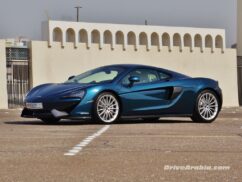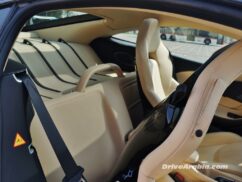2017 McLaren 570GT

| The Good: – Supercar looks – Decent ride, great handling – No shortage of power |
The Bad: – Supercar practicality – Very expensive in its niche – Never quiet enough for a GT |
McLaren — a supercar brand that started with a bang more than two decades ago with just one model, and reborn just a few years ago as a full-fledged carmaker with an ever-expanding line-up — has some very capable cars that can go toe-to-toe against the Italians, but look past the basic specs, and you realise they’ve placed all their eggs in one basket, churning out models all based on a similar platform and engine. After the 570S and 540C models debuted a bit more than a year ago, as a mildly more practical version of the 650S (and its numerous variants), there is now a third version called the 570GT.
The 570GT’s position in the McLaren’s “Sports Series” lineup is a bit odd, considering the 540C was supposed to be the more comfortable counterpart to the 570S, which itself was supposed to be the more practical counterpart to the similarly-sized 650S (from the pricier “Super Series”). The most obvious external change on the GT, aside from the 20-inch multi-spoke wheels, is the replacement of the ‘flying buttresses’ with a proper rear window over the engine compartment, apparently to add a shallow luggage compartment there.
The ‘entry-level’ Sports Series cars are actually positioned as a rival to the Porsche 911 Turbo S, which is essentially the flagship of Stuttgart’s legendary rear-engined range. The McLaren is clearly a more flamboyant car, with intricate details on the body that are not visible in photos, such as the separate panels at different depths that make up the door skins, as well as subtle aerodynamic paths for air to go around the car, such as through the door panels. Unlike the pricier McLaren 650S which is made up entirely of carbon-fibre and composite body panels, the 570S additionally uses a few aluminium panels to reduce costs. It still has a carbon-fibre tub, modified to lower the door sill and allow easier access into the cabin without pulling a leg muscle, though it’s still not easy enough for potential geriatric or out-of-shape owners.

Following the theme established by the 570S, which itself was built to be more practical for everyday use, with scissor doors that open wider and close with a soft touch, while offering features such as more a/c vents, useable cup-holders and extra storage spaces, the 570GT takes it one step further with the aforementioned rear tinted-glass panel which is side-hinged and unlocks via remote to reveal a leather-clad surface with plastic railings on it, potentially to tie down a small weekend suitcase exposed to the sun. However, there is still the issue of not being able to open the swing-up doors when parked next to a high curb or even too close to another car, thereby limiting where you can park around town.
The cabin trim is perfectly done, with beautiful stitched leather all over the curvy dash, doors and seats. Being a GT, the upholstery is done in two-tone black-beige rather than gaudier colours, with well-bolstered bucket seats rather than cramped racing chairs. There is an additional carpeted boot under the front bonnet good for a couple of bags, as well as a couple of shallow cup-holders, cubbies, door pockets and a glove-box.
Tech includes a good stereo, controlled via a portrait-positioned touchscreen whose monochromatic interface is mostly thin lines on a black background. We were able to figure out how to change radio stations and connect our phones, but some of the other functions can be a bit complicated to figure out. The dual-zone auto a/c didn’t struggle in January afternoon weather. Other features include smart keyless entry and start, 3 USB ports, LED headlights with LED running lamps and tails, power windows and mirrors, a detailed LCD gauge cluster, non-opening panoramic glass roof and memory seats. Safety features include front, side and knee airbags, ABS, ESP, parking sensors and a rear camera awkwardly placed close to the ground.

Powered by McLaren’s usual 3.8-litre turbo V8, in this application it makes 562 hp at 7500 rpm (or 570PS, as the name implies) and 600 Nm of torque at 5000-6500 rpm, with an 8500 rpm redline. The different tuning is readily apparent. Compared to the frantic McLaren 675LT we drove before, the 570S feels more subdued, still fast but not throwing all that power at you with the same level of violence at lower revs. The motor is a fair bit quieter under 4000 rpm, and spins below 2000 rpm at highway speeds, just like any commuter car. The engine is always audible, but it’s more of a docile hum, opening up to a throaty roar only on full throttle.
During our January test, we garnered a 0-100 kph time of 4.4 seconds with a squeal-free launch and a full tank of fuel. It’s supposed to be much quicker, but the electronics seem to intentionally bog down the power initially to kill any wheel-spin, before unleashing all the push a half-second later. Meanwhile, we burned petrol at the rate of 17.5 litres/100 km, although it can likely do better with a lighter right foot.
The gearbox is a 7-speed dual-clutch automatic, making for quick nearly-seamless shifts if left to do its own thing in “sport” mode. It’s also very responsive when using the paddles manually. It’s reasonably quick to move off from idle, not particularly affected by the delayed responses that afflicts many other dual-clutched cars. However, there is an obvious rubber-band effect in reverse gear, with the car lurching unevenly on mild throttle inputs when backing up.
Riding on wide 285/35 tyres, the handling is typical supercar-grade, with very high grip limits, no obvious body roll, and way more capability than anyone will ever get to explore on public roads. The steering offers moderate feedback and is surprisingly light at lower speeds, while firming up nicely at higher speeds. This is the first McLaren we’ve driven without carbon-ceramic brakes (an option that costs as much as a small Hyundai), and the regular steel brakes are perfectly fine in daily driving, strong and with good pedal feel making it easy to modulate linearly.
The Sports-Series 570 models use less-complicated suspension than the Super-Series 650S, but that isn’t readily apparent as the 570GT’s ride quality is pretty decent on good road surfaces, while not being hugely jarring over bumps and imperfections. Forward visibility is fine, but don’t expect to have a panoramic view behind you, although driving is quite manageable using the mirrors. It is also quieter than the 650S, although cabin noise still remains relatively high while doing 120 kph, closer in decibels to Toyota Yaris than Bentley Continental GT. However, while the 570GT is supposed to have slightly softer suspension and slower steering than the 570S, we cannot discern any difference between the two without driving them back-to-back.
As a driving experience, the 570GT is not hugely different from its pricier siblings, yet the changes to make it more practical actually do make it a much more agreeable car that can be driven a bit more frequently, as long as the parking spaces are extra-wide. It makes for a more left-field alternative to a 911 Turbo, maybe not beating it in outright performance or even practicality, but the McLaren’s supercar vibe is stronger than in any of its rivals.
| Price Range: Dh 800,000-950,000 Current Model Introduced in: Body Styles: Engines: Transmissions: Setup: Suspension: |
Brakes: Front: discs Rear: discs Curb Weight: Length: Wheelbase: Top Speed: Test Acceleration 0-100 kph: Observed Test Fuel Economy: |
















Comments
Mashfique Hussain Chowdhury
More photos:
https://www.drivearabia.com/news/2017/05/03/so-we-got-a-2017-mclaren-570gt-dubai-uae/